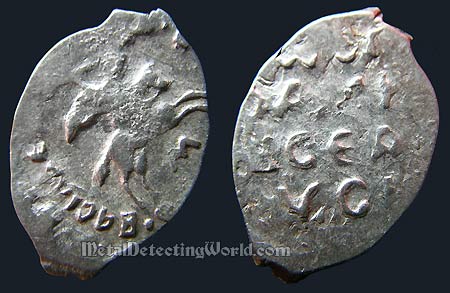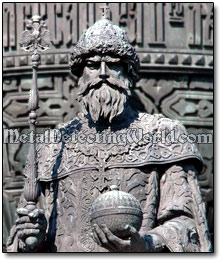
| ⇑ | Next > |

OBVERSE: Image of a horseman with saber, the mint engraver's mark: "М" under the galloping horse, and the circular legend engraved in old Cyrillic letters reads: ".КНZЬ.ВЕЛIKI.IВАНЬ.ВАСIЛЬЕВIЧЬ" ("Grand Prince Ivan Vasilievich"), circular dotted line.
REVERSE: the 4-line legend engraved in old Cyrillic letters reads: "ωСП / ОДАРЬ / ВСЕЯР / УСИ" ("Majesty of Entire Rus"), circular dotted line.
Weight: 0.8 gram
Mint: Novgorod
The coin denomination Denga was the first face-value of the Russian wire money, and later on was a basic monetary unit of currency in the monetary system of Rouble. According to scolars, the word "denga" was derived from a mongolian word "temgha" (also "tangha" and "tamgha"), which meant "a symbol of the clan" in the Mongolian Empire (13-14th century). As an ancestral emblem, tamgha was inherited from generation to generation and was placed on the livestock and landmarks. The number of derivative tamghas gradually developed into khans and state tamghas which were used for any kind of official stamp or seal, and, of course, were placed on coinage.
When the vast hordes of Tatar-Mongols and Turks invaded Rus' in the mid-13th century, Rus' was experiencing the so-called "coinless period" during which no national coinage was struck. The Mongols brought their coinage with them, and the Mongol Empire's dirhams bearing Tamgas were put into circulation to provide a basic medium for trade, commerce and taxation. Also, another interesting fact is that in the Golden Horde, a "danga" was also a seal placed on taxed items.
The Russian coin denomination Denga became one half of a "Kopeck" - a new coin denomination which appeared in circulation during the monetary reform carried out by a mother of the first Russian Csar Ivan IV (Ivan The Terrible) in 1535. The coin denomination Denga disappeared from the Russian monetary system by the 19th century; however, the word "dengi" (plural of Denga) meaning "money" is still commonly used in modern Russia. The word tengha has survived the test of time and, as tenge, has been a national currency of modern Kazakhstan since 1993.
This particular Denga coin was minted under the rule of Ivan III Vasilievich. Sometimes referred to as the "gatherer of the Russian lands", Ivan III Vasilievich (Russian: Иван III Васильевич), also known as Ivan the Great, a Grand Prince of Moscow and a Grand Prince of All Russia ("Великий Князь Всея Руси"), was one of the longest-reigning rulers in Russian history. During his reign from 1462 to 1505, he tripled the territory of his state, renovated the Moscow Kremlin, and laid the foundations of the Russian state.

Number of pages:
Privacy Policy || Cookies Policy